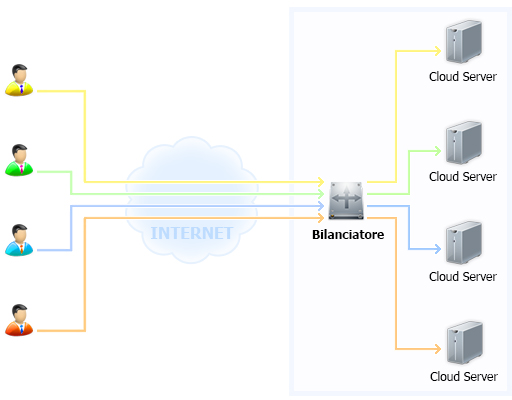With a load balancer it’s possible to distribute the workload balancing it between two or more Cloud Servers. This allows you to optimize the resources of your infrastructure, maximizing its productivity and reducing the response times to a minimum, therefore avoiding possible overloads. Using a load balancer is recommended in all cases whether you require one or more of the following:
- guarantee continuity of the provided service
- manage high traffic levels
- always be ready for sudden peaks in traffic
Obviously to balance the workload you need at least two or more Cloud Servers with identical configuration and which contain the same data.
DARWIN allows you to configure your load balancers, and its connections, directly from the Control Panel, with just a few clicks, easily and quickly.
You can configure your load balancers by the main protocols which are HTTP, HTTPS and TCP simply by selecting from the preset algorithms which are LeastConn and Source.
Furthermore with DARWIN you can monitor your load balancers through simple charts which indicate the workload on the load balancer, in order to prevent overloads, simply by increasing the number of balanced Cloud Servers.
Features of the DARWIN balancers:
- Dedicated IP address
- Easy to configure and manage
- Supports HTTP, HTTPS and TCP protocols
- Supports LeastConn and Source algorithms
- Registration of detailed statistics of load balancer workload
Using a load balancer which intercepts the network requests and sorts them between two or more Cloud Servers, through their redundancy, increases reliability and ensures continuity of the provided service. Should one of the Cloud Servers that are being balanced stop working for any reason, the load balancer will automatically exclude it from the balance redirecting the requests to the other Cloud Servers: this provides the highest guarantee in terms of Business Continuity.
Balancing the structure makes the horizontal scaling of the resources immediate and cheap. This type of configuration of the structure adapts very well to any situation or need which involves a lot of simultaneous traffic; or if you wish to guarantee the continuity of the provided service by reducing the possibility of service “downtimes” to a minimum.
In a balanced structure which includes a cluster of many Cloud Servers which in turn interrogate a single Database Server, there may be the need to increase the resources for the latter (vertical scaling) as it could be required to respond to various simultaneous requests from the various Cloud Servers in the cluster.


